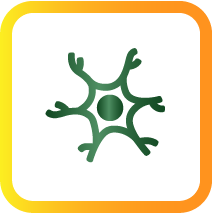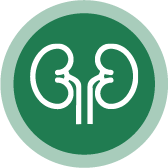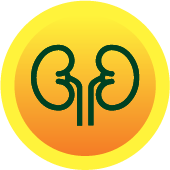
Hereditary ATTR amyloidosis is passed down through family members (genetically inherited). If one parent has hereditary ATTR amyloidosis, there is a 50% chance their child will inherit the mutation (or variant). However, not everyone who inherits the mutation will go on to develop the symptoms of hATTR amyloidosis.
Globally, there are over 150 different mutations in the TTR gene that can lead to hATTR; these can present in specific geographic regions and populations.
hATTR affects everyone differently. Its symptoms can often look like those of other, more common conditions. Genetic testing can help you and your doctor get to the correct diagnosis.
The amyloid deposits caused by hATTR amyloidosis cause illness by damaging the structure and the functions of the organs where they are found. In hATTR, amyloid deposits most commonly accumulate (build up) in:

The nervous system

The digestive system

The heart
Symptoms of hATTR can seem unrelated, as amyloids can deposit in various tissues and organs, and present as more common conditions, making it difficult to diagnose.
Ocular
Symptoms related to the eyes, often causing visual changes. These can include blurred or spotty vision, floaters in your eyes and, in some cases, glaucoma.
Cardiac
Symptoms related to the heart, blood vessels, and circulation, such as shortness of breath, swelling in the feet and ankles, and abnormal heartbeat.
Nephropathy
Symptoms related to damage of the kidneys such as changes to urine and protein in the urine.
Peripheral Sensory-Motor Neuropathy
Pain, numbness, or weakness, usually in the hands and feet, caused by damage to the nerves in the limbs. Symptoms can also include difficulty walking and falls.
Autonomic Neuropathy
Issues with involuntary body functions, such as heart rate, blood pressure, and sweating, caused by damage to nerves that control the autonomic nervous system.
Gastrointestinal
Nausea, diarrhea, or constipation caused by damage to the nerves that control digestion.
Carpal Tunnel Syndrome
Numbness, tingling, or pain in both hands caused by a pinched nerve in the wrists.
Spinal Stenosis
Pain, numbness, or weakness in the legs and feet that can be caused by amyloid deposition in tissues around the spinal cord that puts pressure on the nerves. Your doctor may also call this lumbar (lower spine) spinal stenosis Spinal Stenosis A chronic condition that happens when the space inside the backbone is too small, which can lead to extra pressure on the spinal cord and the roots of your nerves..

















Speak to your healthcare provider about hATTR amyloidosis symptoms, because not all people experience the same symptoms. Note that while the symptoms above are the most common, people who have hATTR-PN may not experience every symptom.
Learn How WAINUA Works to Help Treat hATTR-PN Progression
Learn How WAINUA Works
Is There an Easier Way to Remember hATTR-PN?
Here is a basic breakdown to help you remember what the condition is.
h
hereditary
(passed down from a parent)
A
Amyloidosis
(group of diseases caused by misfolded proteins) of
T
Transthyretin
protein that transports
T
Thyroxine
(thyroid hormone) and
R
Retinol
(vitamin A)
-
P
Poly
(many)
N
Neuropathy
(damage to nerves throughout the body)
WAINUA reduces TTR protein production, may prevent your neuropathy symptoms from getting worse, and may improve your quality of life.* Individual results may vary.
*As measured by mNIS+7 score and Norfolk QoL-DN score








